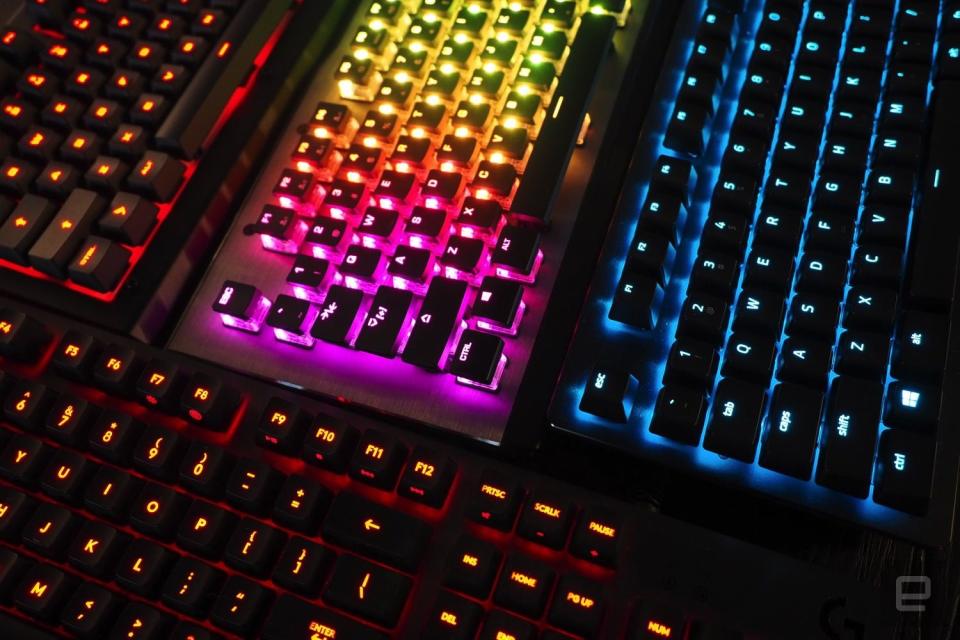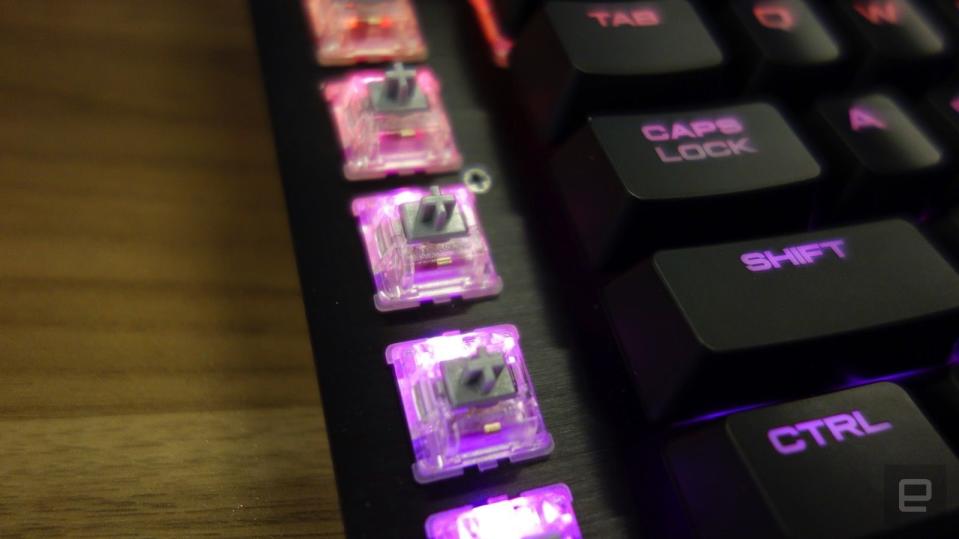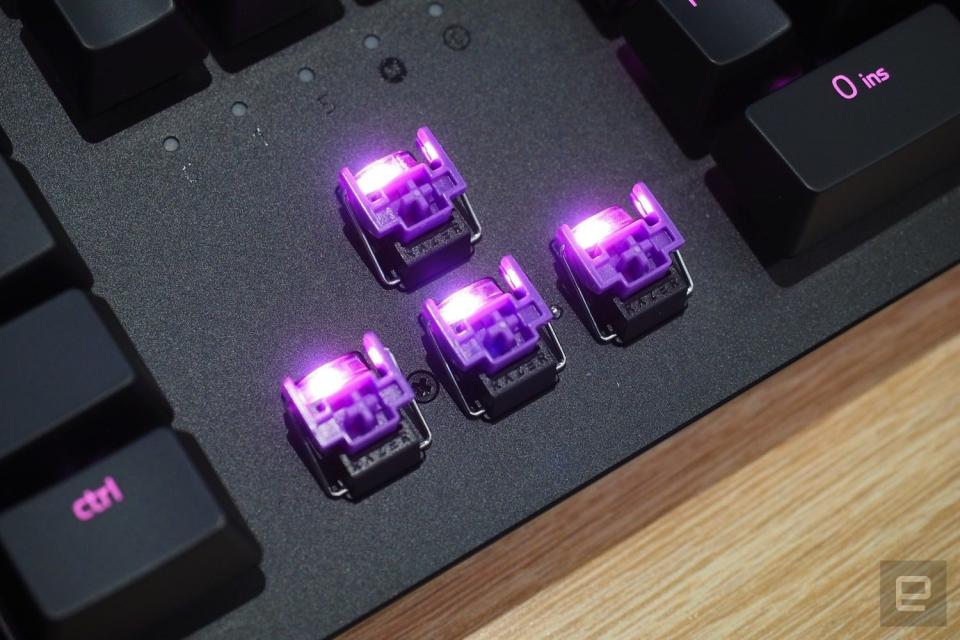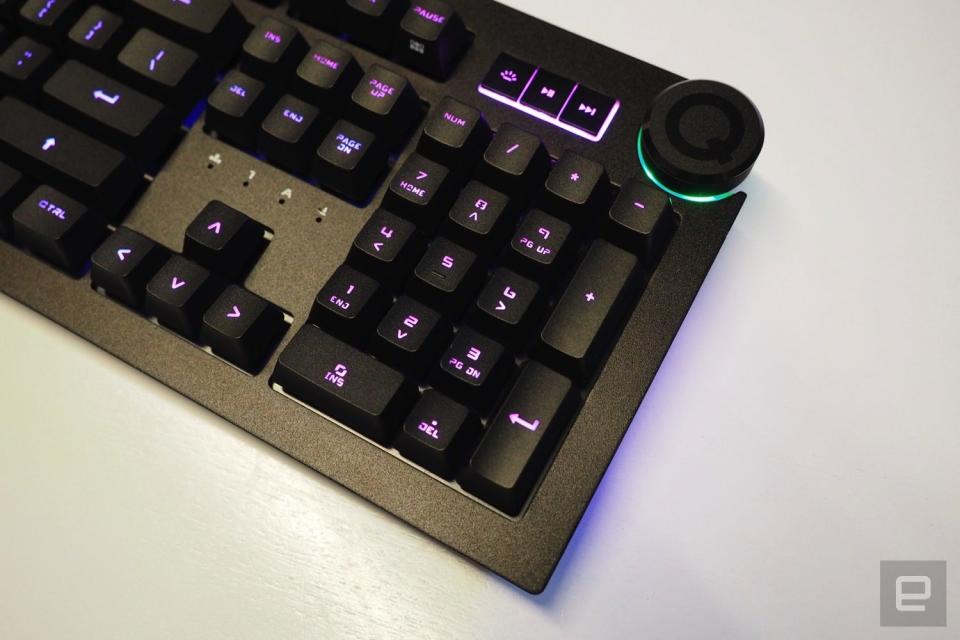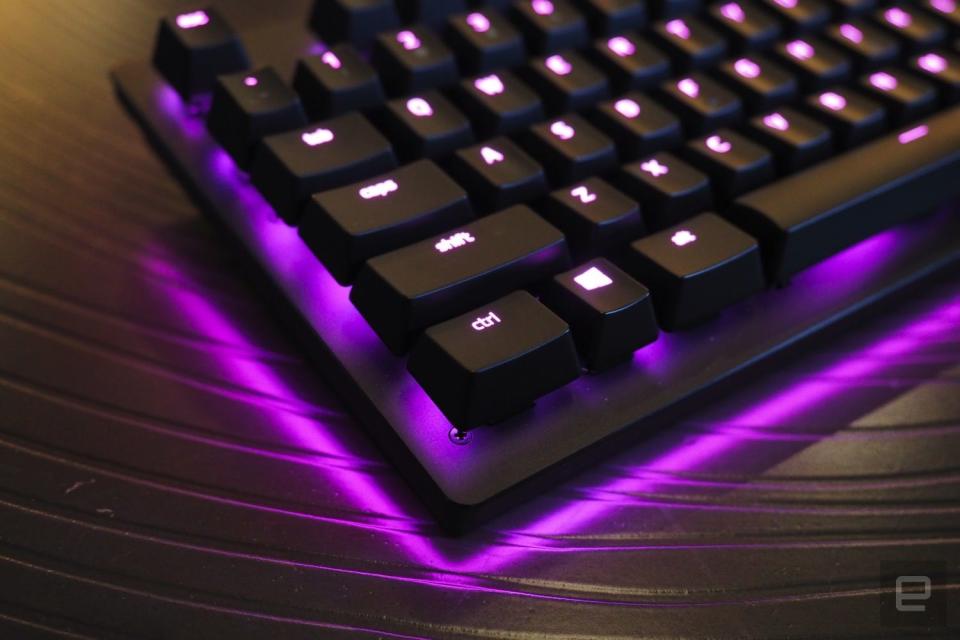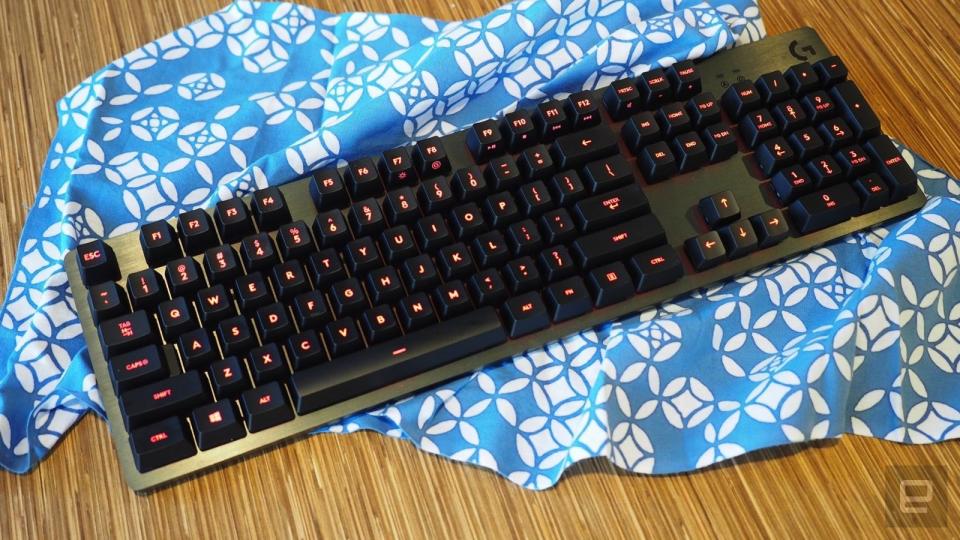How to buy a gaming keyboard
They're more than just a bunch of pretty colors.
When you build a gaming rig, you're going to find yourself talking a lot about numbers. Higher and bigger are generally better, especially when it comes to stuff like processor speed, amount of RAM and the size of your hard drive. But when it comes to finding the perfect keyboard, you'll be confronted with a whole new set of metrics, along with shapes and colors that won't initially make much sense. What the hell is a dome switch? And why are we talking about green cherries?
Membrane vs. dome vs. mechanical
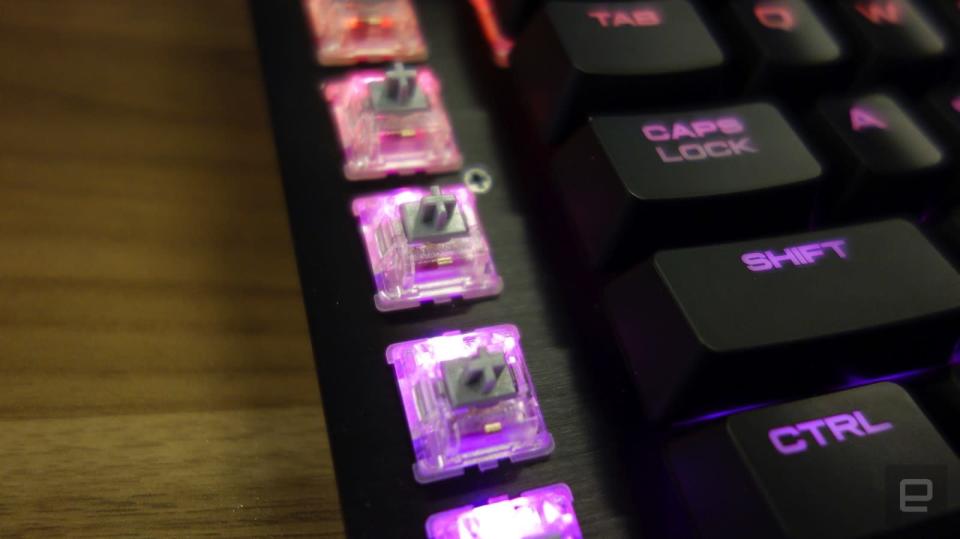
Most people don't give a lot of thought to key mechanisms. We usually just stick with whatever came built into our laptops. Portable machines used to be the domain of membrane switches, which are basically pressure-sensitive pads that are prized for their low profile and quiet key press. But they generally suck for serious typing and gaming. Some machines and tablet keyboards still use them, but for the most part laptop makers have switched to scissor switches like Apple's sometimes finicky butterfly mechanism.
Scissor switches are a type of dome switch: a hybrid button that puts a folding mechanism under each key that then presses down on a membrane when you push on it. This way, you get the tactile feel of mechanical keys along with the quiet typing and slim profile of a membrane. Most consumer keyboards these days are dome switches -- not just the ones built into laptops but also some of those included with desktop purchases. There are also quite a few gaming keyboards that use dome switches to outstanding effect. They're more expensive than membrane keyboards but cheaper than mechanical setups, making them a good choice for first timers or those on a budget.
Finally, there are mechanical switches. You've probably heard gamers and programmers alike extoll their virtues. A mechanical key is all spring and lever-based, no spongy membrane in there. That means the key presses are precise and responsive, and they give you a lot of feedback when you type. They're also very loud, which means they might not be the best choice for office work or any other environment where people exist. All those fiddly bits mean that mechanical setups tend to be more expensive than other keyboards. But many recent models now equip LED lighting under each key, so at least you're getting a customizable light show for the price.
The colors!

When people talk about "blue" or "red" keys, they're not talking about the lighting scheme. What they're actually discussing are types of mechanical keys manufactured by a company called Cherry. For years Cherry MX keys were the gold standard for mechanical setups, with many manufacturers sourcing parts from them. Now those patents have expired, so we're starting to see a lot of gaming companies like Razer and Logitech whip up their own in-house solutions and even experiment a bit with technologies like "opto-mechanical" keys.
Plenty of companies still use Cherry keys, though, and will often advertise that in the product description. Some will even let you choose which ones you want. The keys are named by the color of the stem at the center of them, with each representing a certain feel and sound profile when you type. Some Cherry keys might be exclusive to certain manufacturers. For example, only Corsair markets Cherry MX Speed keys, which require little pressure to activate. (However, some companies sell silver Cherry keys, which are basically the same thing.)
Razer and Logitech also label their own lines with color names to similar effect, with each denoting a different combination of key feel and noise.
Cherry | Razer | Logitech | |
Linear and quiet | Red, white, black, silver | Yellow | Romer-G Linear |
Tactile and quiet | Brown | Orange | Romer-G Tactile |
Tactile and clicky | Blue, green | Green | GX Blue |
Both Razer and Logitech make keys of comparable quality to Cherry MX but with a different feel, so which setup you go for comes down to personal preference and budget. Well, those and your immediate environment. People working in private spaces, either at home or at work, might like something clicky, as it offers great response, and that sound -- well, it just makes you feel super productive. But if your gaming setup is out in the open, like at a desk in your den or living room, you'll want to opt for something quieter. And though Razer likes to tout its yellow and orange key mechanisms as silent, that's not actually true: There's still some noticeable output, and hammering away on them at home might get you dirty looks from your roommates.
Layout
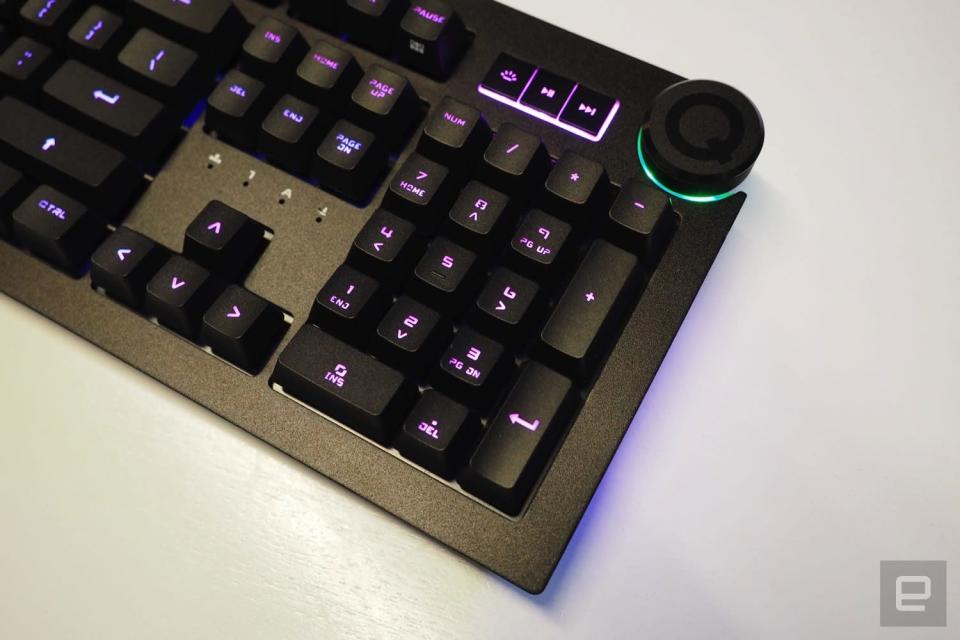
Picking a keyboard isn't just about what type of mechanism lies underneath each key though. What the keys and buttons can do and how many you have also matter. Most keyboards have between 88 and 101 keys. That's a big difference, and it mostly comes down to whether the keyboard includes a number pad and/or macro keys. Most keyboards include a number pad, and you'll probably find it useful when playing games. But if you know for sure you won't be needing those keys and you want something a little smaller on your desk, consider looking for a tenkeyless deck, which omits the number pad.
If you do indeed need some extra keys for programming game commands (macros) for your favorite MMORPG, there are lots of great options that include a set of (usually) six programmable keys on the side. In this case you want a major manufacturer with easy-to-use, robust software supporting its peripherals. Then setting macros becomes as easy as clicking on a diagram or selecting actions from a menu. Logitech, Corsair, SteelSeries and Razer all have good interfaces that work with their other peripherals, too, so once you pick up a keyboard from a company you might be tempted to grab its mice and headsets as well.
One thing that many gaming keyboards have that you'll find useful are media keys. These are usually located in the upper-right-hand corner of the deck and have controls for play/pause, skip track and some kind of volume control -- maybe even a dial. They make it possible to adjust the volume without your hands leaving the keyboard, which is crucial if you're in the middle of a match. And you can mess around with your music without having to leave the window you're currently working or gaming in. There's no reason not to have them if you choose a keyboard with a number pad.
Appearance
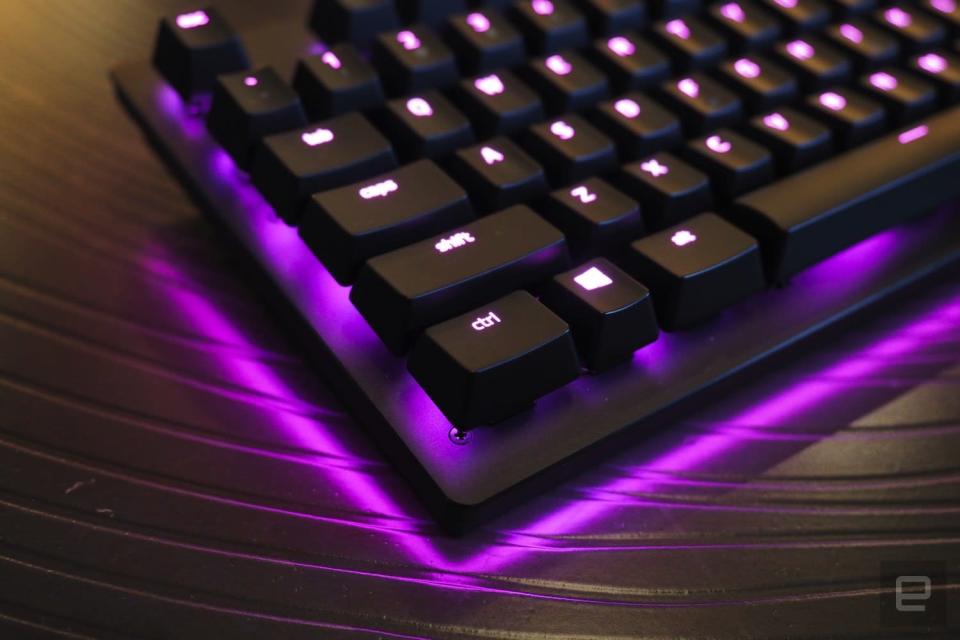
So you care a lot about how your keyboard looks, and that's OK. It is sitting on your desk, after all, and you wouldn't want something that clashes or draws too much attention. Most gaming keyboards tend to be blingy, which is fine at home but maybe less so in an office environment: You need to find something a little more subdued like Das Keyboard or Logitech, or at least something whose LED lights can be turned off. Don't buy a keyboard that doesn't let you adjust the colors: You never know when you might need a change, or maybe the animated rainbow beneath your fingers is a little too hypnotic.
Also: We hope you like black. Maybe with some red. You're going to see a lot of it.
If you get tired of how the keys themselves look, Cherry setups have a huge advantage in this regard: You can purchase new keycaps and replace the tops of your keys entirely. There's a variety of colors to choose from. Do you prefer teal, or maybe gray and purple for an SNES feel? You can do that. You can also buy textured keys to help with your typing. (Some keyboards, even ones with proprietary key setups, pack in a set of textured WASD keycaps for this purpose.)
Many keyboards come with wrist rests, and if you're prone to RSI this can be a godsend. But your choice of a keyboard shouldn't hinge on whether it includes one. Most let you remove it if you don't like it (I certainly don't), and if your favorite keyboard lacks a wrist rest you can always buy one from pretty much any computer retailer for less than $20 and even choose the color and style.
Price
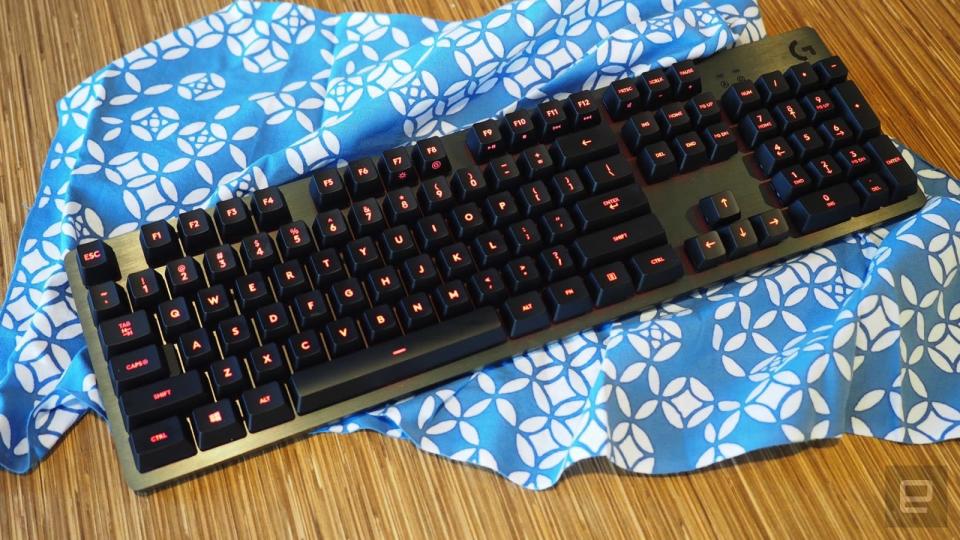
Obviously your budget is going to play a part in what you eventually go with. You can buy a mechanical keyboard from a no-name manufacturer for as little as $30, but even the bigger brands have models you can snag for $40 or $50. However, the better ones start around $80, and for the best quality I'd advise putting aside around $130 if possible. There are models from companies like Das Keyboard that cost more than $200, but there's no real advantage to spending that much when Corsair and Logitech offer great decks for less.
If you're thinking about getting a dome switch instead, know that the cost savings is minimal. You can pick up dome-switch gaming keyboards from Logitech and SteelSeries for as little as $30 to $50, and the quality has greatly improved in recent years. Still, mechanical keyboards offer superior performance, and you'll find that a lot of companies have converted their lineups to mostly mechanical at this point. Spend your money on a dome switch if noise is your No. 1 concern.
What do you buy?
Your keyboard is something you'll hope to have for a few years at least, so ultimately it's best to get the one that takes care of your biggest pain points. Most people just need one that's comfortable and easy to take care of. Corsair decks like the K70 and K95 are incredibly sturdy and use Cherry MX keys, so you can swap the keycaps out easily when they wear down. In the Engadget office we've also become enamored of Roccat's new Vulcan model, which uses a chiclet-like key layout that sort of feels like a laptop keyboard. It's also way easier to clean than most gaming decks.
First timers putting together a full gaming setup who also need to pick up a new mouse and headset will find it's better to try to stick with one company. That way, you won't have to juggle multiple configuration apps. Logitech and Razer offer the best all-around lineups of gaming accessories at multiple price points. The Logitech G213 is an extremely affordable RGB dome model for $50, or you can snag the mechanical G512 for $100 and then pair either with the G305 wireless mouse and G Pro headset. If you're more into Razer's style, the BlackWidow Ultimate is water resistant and only costs $110: perfect if you have a propensity for knocking over drinks in the middle of tense matches. For audiophiles, it might be best to give SteelSeries' Apex lineup of keyboards a look: Its Arctis headsets sound fantastic, and its mice are pretty great as well. The Apex M500 has a slim profile, uses Cherry MX switches and only costs $100.
If you need to keep the noise down lest you anger a family member, roommate or co-worker who abhors the sound of typing, Logitech has you covered with its Romer-G Linear keys. You can find them on decks like the G513, and they're some of the quietest mechanical switches we've found. But there's no such thing as a truly silent mechanical keyboard... for now. Razer's orange switches also make a good effort at keeping the noise down, but the only model that's delivered is the new BlackWidow Lite, which slips O-rings under each key to dampen its sound even more. The only caveat is that it's a tenkeyless deck, so those who need or prefer a number pad are out of luck.
And finally, if you're all about that bling, any of Razer's BlackWidow X Chroma series will do you nicely. The company also sells desktop speakers, headphone stands and even LED strips for desktop towers that hook into its signature lighting system. You can even sync your Chroma setup with Philips Hue and get your lamps and ceiling lights in on the action. Of course, this is best if you live alone, as flashing green-and-purple lights aren't much fun if you're not the one gaming.


